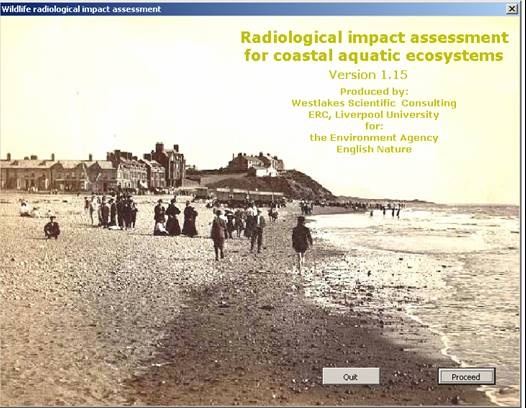Page History
England & Wales Environment Agency R&D128
Developed to assess Natura 2000 sites for compliance with the EC Habitats Directive in England and Wales, this MS Excel spreadsheet model uses a similar approach to that of the ERICA Tool, although a smaller range of organisms and radionuclides is considered. Dose conversion coefficients (DCCs) are estimated using simple functions for energy deposition in a medium of unit density from point isotropic sources to represent the absorption of photons and electrons. Energy absorbed fraction functions are fitted separately for photons and electrons to provide an interpolation between calculated values. These functions are then integrated numerically using a stochastic (Monte-Carlo) algorithm to calculate the absorbed fraction. The model uses CR values from literature reviews to estimate activity concentrations in biota based on media concentrations. Guidance is provided on how to estimate CR values if they are missing for a given radionuclide-organism combination (Copplestone et al. 2003). The nature of this guidance ranges, for example, from using a CR value for an organism of similar ecology through to assuming that the CR value is 1 for a terrestrial organism if no data were available to suggest it may be higher than this. The guidance aims to provide conservative values where data-derived (or site-specific) CR values are lacking as the overall approach to the assessment is to be conservative.
The spreadsheet-based models, provided with this approach, are freely available:
Coastal model
Terrestrial model
Freshwater model
See England & Wales EA for a summary of the application of the R&D128 approach to assess protected sites which may be impacted by authorised discharges of radioactive release.
Allott and Copplestone (2008) state that there is an intention to revise the EA R&D128 assessment methodology to include more realistic data from the ERICA Tool. Currently, assessments within the UK could not rely solely on the use of the ERICA Tool as it does not consider noble gas releases to the atmosphere (the EA R&D128 methodology does). Noble gases can constitute a major component of releases, for instance, they constitute at least 80 % of the total atmospheric releases envisaged from one of the nuclear reactor types currently under consideration in England.
The R&D128 methodology has been applied in intercomparison exercises of the IAEA's EMRAS programmes.
Key documentation for the R&D128 methodology
Copplestone, S Bielby, SR Jones, D Patton, P Daniel and I Gize, Impact assessment of ionising radiation on wildlife (2001)
D Copplestone, M D Wood, S Bielby, S R Jones, J Vives and N A Beresford, Habitats regulations for Stage 3 assessments: radioactive substances authorisations (2003)
| Align | ||
|---|---|---|
| ||
|
